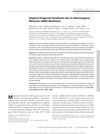TLDR Studying premature aging syndromes helps understand human aging and suggests potential treatments.
The document discussed premature aging syndromes, particularly Hutchinson-Gilford Progeria Syndrome (HGPS), caused by mutations in the nuclear lamina. It highlighted that the mutant protein progerin led to premature cellular senescence, abnormal nuclear architecture, DNA damage, and loss of heterochromatin. Treatments like farnesyltransferase inhibitors (FTIs) showed limited success, while combined treatments with statins, aminobisphosphonates, and mTOR inhibitors like rapamycin showed more promise in mouse models. The study emphasized the need for further research to understand the link between progerin expression, chromatin changes, and DNA damage, and to develop effective anti-aging therapies.
85 citations
,
March 2008 in “Journal of Cell Science” The mutation causing Hutchinson-Gilford progeria syndrome leads to severe skin problems and early death in mice.
32 citations
,
July 2017 in “Oncotarget” Alternating treatment with two drugs could help cells in a rapid aging disease.
4 citations
,
May 2023 in “Cells” Baricitinib and its combination with lonafarnib improve fat cell formation in certain genetic disorders.
 June 2023 in “GSC Advanced Research and Reviews”
June 2023 in “GSC Advanced Research and Reviews” Hutchinson-Gilford Progeria Syndrome causes rapid aging from a genetic mutation, with no cure but ongoing research into potential treatments.
 115 citations
,
October 2009 in “The Journal of clinical endocrinology and metabolism/Journal of clinical endocrinology & metabolism”
115 citations
,
October 2009 in “The Journal of clinical endocrinology and metabolism/Journal of clinical endocrinology & metabolism” The research found that Atypical Progeroid Syndrome has unique symptoms and is not caused by the buildup of a certain mutant protein.
2 citations
,
June 2018 in “International Journal of Pharmacological Research” Hutchinson-Gilford Progeria Syndrome caused rapid aging due to a genetic mutation, with treatments to manage symptoms.

